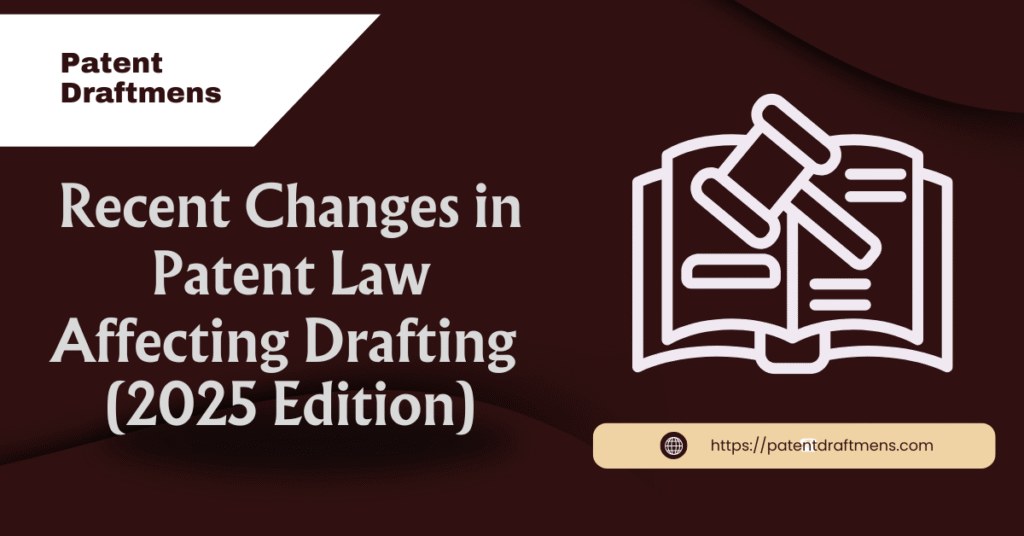Introduction
You’ve made something new. Maybe it’s a cool app or a smart tool. You want to protect your idea. So you go to file a patent. But guess what? The rules just changed. The way you write your patent is not the same anymore.
Patent law is always changing. These changes affect how we write and file patents. Some updates help inventors. Some make things harder. And some rules are made for using AI in drafting.
These updates matter to:
- Inventors
- Startups
- Patent lawyers
- AI drafting tools
If you’re any of these, you need to know what changed.
In this blog, you’ll learn:
- Key changes in patent law in 2025
- How they affect patent drafting
- Tips to follow the new rules
- Who benefits (and who doesn’t)
- FAQs with simple answers
Let’s make it all easy to understand.
What Is Patent Law?
Patent law protects your ideas. When you invent something new, patent law gives you rights over it. No one else can make, sell, or copy your idea without your OK.
But to get a patent, you need to write a detailed patent draft. That’s where the law steps in. The law tells you:
- What to include
- What language to use
- What NOT to write
- How to claim your idea
And now, these rules are updated.
Key Patent Law Changes in 2025
Let’s look at the most important changes that affect patent drafting.
1. Stricter Claim Clarity Rules
Now, patent claims must be even more clear. No vague words. No confusing terms. If a claim is not 100% clear, it may get rejected fast.
What to do:
Use short, plain words. Explain each part well. Define terms clearly.
2. Rules on AI-Generated Drafts
Many people now use AI tools to write patent drafts. In 2025, new laws say:
- You must disclose if AI helped write your draft
- The human author must take full legal responsibility
- AI tools must not copy from past patents directly
What to do:
Use AI tools, but review the draft yourself. Be honest about using AI.
3. Global Format Standardization
Different countries had different formats. But now, WIPO and other global bodies are working to make one global format.
What changed:
- Abstract word limit is fixed
- Specific headings are now standard
- Claims must follow global numbering styles
What to do:
Follow the new template. Use the global format even if you file in just one country.
4. Data and Software Patents Need More Proof
Got a software idea? In 2025, the law needs real-life examples. Just showing code is not enough. You must prove that it works in the real world.
What to do:
Add examples. Show how your software or data tool solves a real problem.
5. New “Enablement” Rules
Now you have to prove that someone skilled in the field can build your idea just by reading your draft. If your writing is too vague, your patent might fail.
What to do:
Explain your idea step by step. Include diagrams, process flow, and examples.
How These Changes Affect You
For Inventors
If you are an inventor, these new rules mean you must tell your idea better than before.
- You can’t be vague. You must explain how your invention works, step by step.
- Use simple words. If a 10th grader can’t understand it, revise it.
- You must show how your idea solves a real problem. No fluff.
- You need to include examples, diagrams, and flowcharts.
- If you’re working on tech or software, add a real use-case.
Why it matters: A strong draft means your idea is protected. A weak draft can get rejected.
Extra Tip: Don’t try to write it all yourself. You may need a patent expert to help. This saves time and avoids rejection later.
For Patent Writers
Whether you’re new or experienced, the new rules change how you write patents
- You now need to write each section in more detail.
- You can’t just copy-paste from old patents anymore.
- Every claim must be sharp, focused, and easy to read.
- You can use AI tools, but only as a helper.
- The final work must be reviewed, edited, and approved by a human.
Example:
Old way: “A system for data transfer.”
New way: “A wireless system that transfers encrypted files using 128-bit secure protocol within 3 seconds over Wi-Fi.”
Extra Tip: Keep up with legal changes monthly. One missed rule can cost your client.
For AI Tools
AI tools are popular in patent writing. But they now need to play by the rules.
- AI must now be more accurate and aware of legal terms.
- AI can’t copy from older patent documents word-for-word.
- If AI helped in writing, the human must review and take full responsibility.
- Tools must include more legal filters to guide the user.
Best Use of AI:
Let AI help with grammar, structure, and formatting. But let humans handle the technical and legal accuracy.
Extra Tip: AI tools that show “legal warnings” or “compliance tips” are better choices now.
For Startups
If you’re a startup, you want to protect your idea fast — but now you have to do it right.
- Filing a patent may cost more due to longer drafts and legal checks.
- But this also means your patent is harder to steal and gives you an edge.
- Startups can still use AI tools to speed up the draft, but they must double-check everything.
- These new rules make your patent more global-ready, so you can launch in more countries.
Why it’s good: Investors trust startups with strong, well-written patents. You may even raise more funds.
Extra Tip: Use AI tools for the first draft, then get a patent lawyer to finalize it.
Tips To Draft Patents Under New Rules
Here are the best ways to stay safe, clear, and updated when writing patents in 2025:
Use Plain English
Write like you’re talking to a 10-year-old.
No legal jargon. No complex tech words without meaning.
Bad: “A mechanized rotary impeller for hydrodynamic propulsion.”
Good: “A spinning part that pushes water to move a boat.”
Label Every Figure, Claim, and Part
Make your draft easy to follow.
- Each diagram must have a clear name.
- Every claim must be numbered.
- All parts in drawings must match their description.
Tip: Use labels like “Fig 1: Top View of Invention” or “Claim 2: Method of Data Storage.”
Add Use-Cases for Software or Apps
Don’t just show code. Show what the software does.
- Add a real-world example.
- Mention how it solves a problem.
- Include screenshots or flowcharts if needed.
Example: “This app lets doctors book appointments in 2 steps, saving 10 minutes per patient.”
Check That Your Claims Don’t Overlap
Each claim should protect a different part of your idea.
- Don’t repeat the same point in different ways.
- Make sure each claim adds something new.
Tip: Think of each claim like a “layer” of protection. Cover all sides, not just the same one multiple times.
If AI Helped You Draft, Say So
New law says you must disclose AI help.
Example: In the “Disclosure Statement,” you can write:
“This draft was prepared with the aid of an AI language model and reviewed by [Your Name].”
Add Step-by-Step Instructions
Show how to build, use, or run your invention.
- Use bullet points or flowcharts.
- Keep each step clear and short.
- Use real numbers, tools, and materials when possible.
Example:
Step 1: Plug in the sensor
Step 2: Press start button
Step 3: Data appears on the screen within 3 seconds
Use the New Global Format Template
Many countries now follow the same format.
Your patent draft must include:
- Title
- Background
- Summary
- Description of Drawings
- Detailed Description
- Claims
- Abstract (Max 150 words)
Tip: Download WIPO or USPTO format guides to stay on track.
Example: Before vs After (2025)
Draft Style | Old Way | New Way (2025) |
Claims | Broad and vague | Sharp and detailed |
AI Help | Not mentioned | Must be disclosed |
Abstract | Any length | Now max 150 words |
Software Patents | Idea-focused | Use-case required |
Format | Different per country | One global style |
Who Gains from These Changes?
- Inventors who are clear
- Lawyers who stay updated
- AI tools that adapt fast
- Startups who follow the rules
Who May Struggle?
- Those using vague claims
- AI-only draft writers
- People skipping legal help
- Anyone not reading the updated rules
Final Thoughts
Patent law in 2025 is more clear, strict, and smart. That’s a good thing. It helps real inventors. It blocks vague ideas. But it also means you must draft better.
Use plain words. Add real proof. Use AI with care. Work with experts. The new rules are not scary — they’re just clearer. If you follow the rules, your patent is more likely to get approved.

